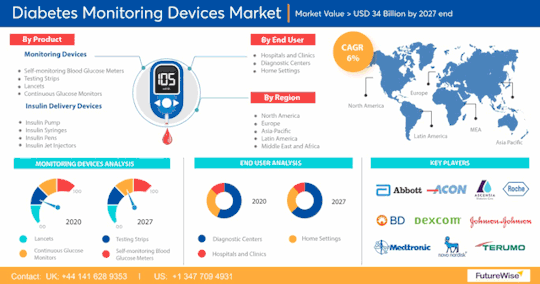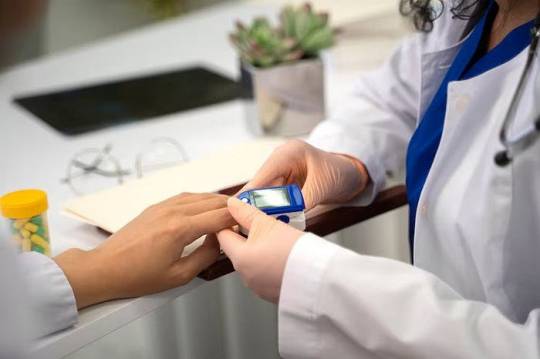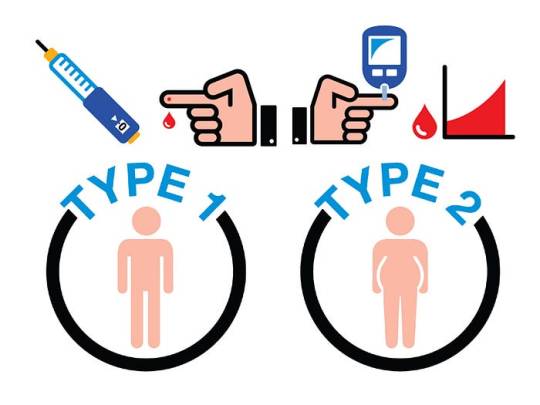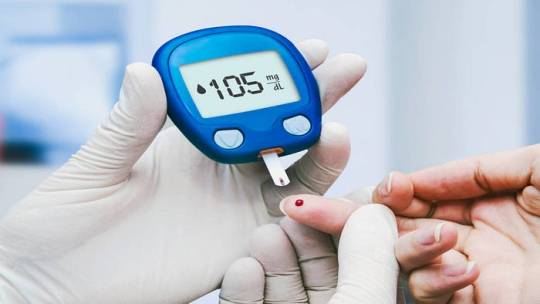#Insulin During Pregnancy
Link

0 notes
Text

Managing diabetes during pregnancy with insulin is crucial to ensure the health of both the mother and the baby. Proper insulin therapy can help control blood sugar levels and reduce the risk of complications, such as premature birth and birth defects.
Read More: https://www.drshubhragoyal.com/welcome/blogs/diabetes-management-during-pregnancy-with-insulin
#Insulin Dosage#Diabetes Management#Diabetes during the First Trimester#Prenatal Care#diabetes management during pregnancy#impact of diabetes on foetal development#Best Gynaecologist in Agra#Gynaecologist in Agra#Shubhra Goyal Gynecologist#Best Gynecologist Doctor In Agra#Top Gynaecologist In Agra
2 notes
·
View notes
Text
Exploring the Intricacies of Type 4 Diabetes: Gestational Diabetes Mellitus
Greetings, esteemed readers, and welcome to this all-encompassing, highly detailed guide centered on the elucidation of Type 4 Diabetes, an intriguing and somewhat less ubiquitous entity compared to its better-known counterparts, Type 1 and Type 2 Diabetes. Our paramount objective within the confines of this article is to embark on a comprehensive exploration, traversing the labyrinthine…

View On WordPress
#blood sugar levels during pregnancy#diabetes and pregnancy outcomes#Diabetes during pregnancy#diabetes management during pregnancy#exercise during pregnancy#GDM#gestational diabetes#gestational diabetes mellitus#gestational diabetes symptoms#gestational hypertension#glucose challenge test#glucose tolerance test#healthy pregnancy#high birth weight#insulin injections during pregnancy#Insulin Resistance#macrosomia#managing blood sugar during pregnancy#managing gestational diabetes#preeclampsia#Pregnancy and Diabetes#pregnancy and insulin#pregnancy and nutrition#pregnancy complications#pregnancy diabetes#pregnancy diet#pregnancy health#pregnancy health tips#prenatal care#prenatal screening
0 notes
Text
Andy's Favorite Girls

Trigger warning: gestational diabetes, type I diabetes, childbirth, fluff
Summary: Andy , Joy, and Joelle welcome Penelope Rose Barber.
The nursery is set up. The crib and the changing table is built. You're busy folding onesies, and Andy is busy setting up the curtains. This is almost a flash back to six years ago, when you were pregnant with Joy. Only the theme of the nursery is different. Joy's theme was a nice, spring theme, and the theme for Penelope's nursery was a nice, flower garden theme.
Just like six years ago, Andy has his head resting on your nine months pregnant belly, and he kisses your belly.
"I love you, Penelope Rose," says Andy. Penelope kicks, and Joy walks in the nursery, carrying her back pack. It's Joy's last day of kindergarten, and she is excited.
"Mommy, Daddy, school's finally over!" says an excited Joy.
"I know, baby," says Andy.
You yawn, and Andy helps you up.
"Oh, honey, you look exhausted. Here, why don't you go take a nap for a bit, I'll take care of Joy," says Andy. Andy had promised Joy a trip to the beach this weekend, and you would go, too. Getting some sun would be good for you. You were hoping that you wouldn't go into labor before then.

Andy helps you on the bed, and gets your feet up. You don't remember your feet aching this bad when you were pregnant with Joy, so Andy sat on the edge of the bed, put your feet in his lap, and started to rub them. You fall asleep, and Andy covers you with a blanket.
Andy goes to make Joy her lunch, and he puts your lunch on a tray, and delivers it to you.
"Thank you, Andy," you say, with exhaustion in your voice.
"Oh, honey, this pregnancy has really worn you out, you were never this exhausted with Joy," says Andy, sympathy in his voice. You never were this tired with Joy, either. In fact, you were a ball of energy throughout most of Joy's pregnancy.
You were at a regular follow up appointment when you had to be given a blood test. The doctor found some sugar in your urine, and he had requested a blood test just because he had suspected that you had gestational diabetes. The blood test confirmed it. The fact that you were just constantly nauseous and tired all the time. You had no idea what causing this, and your doctor followed his gut instinct. He ordered the blood test and the UA, and the blood test confirmed it. You had to spend a few days in the hospital when Andy found you passed out on the kitchen floor one morning after Andy and Joy came back from her dance class. Andy kept the house running, and even worked from home.

You were given insulin, and even took it every day, you were still tired. The nausea had all but gone away, but you were still tired. The fatigue was making you feel even worse. You felt as if you had zero energy to do things. Andy and Joy were helping you get through this. Joy was drawing pictures to make you happy, Andy was taking care of you and running the house. He made sure that you got plenty of rest, took your insulin, and checked your blood sugar every day. Every day, Andy and Joy would visit you in the hospital until you were released.

Thanks to your PCP and your ob/gyn, they kept pushing for tests. There was just something off about this diagnosis. It was discovered that the gestational diabetes was only the beginning of something. You were eventually diagnosed with type I diabetes. How nobody caught it, you'll never know. Your doctor explained that the symptoms manifested themselves during this pregnancy.
Andy made sure you ate at frequently to keep your blood sugar steady, he made sure that you took your insulin, and he made sure that you drank plenty of water. He always brought you some juice, too, in case you started to go into diabetic shock. He even made sure that you checked your blood sugar before you ate and made sure that you checked your blood sugar often.

You were pregnant with baby number two. You now had to live daily life as an insulin dependent diabetic who was pregnant.
"Oh, honey. I know you didn't ask for this", says Andy, who is now giving you a foot rub.

"I know, Andy", you say, yawning.
You start going to sleep, and Andy covers you with a blanket. He kisses you on the cheek, and goes back to help Joy clean the kitchen, and wash up after lunch.
You're resting in bed, knitting a pair of booties for Penelope, when you felt a sharp pain. Andy comes up to check on you, and he sees you doubled over.
"Andy, I think it's time. AH!"you scream in pain.

Andy helps get you up, and places his arm around you. He kisses your forehead.
"Are you sure it isn't Braxton Hicks?" asks Andy. Andy fetches you a glass of water. You drink the water.
You drink the water, the half an hour later, another contraction washes over you. Andy calls the doctor, and tells Andy to get you to the hospital. Given your type I diabetes, your doctor didn't want to take chances and wait. The sooner you set up on a fetal monitor, blood sugar monitor, and insulin pump, the better.


Andy manages to get you to the hospital. The nurse sets you up on a fetal monitor and an insulin pump, and a blood sugar monitor. Eventually, your contractions get closer together. You're ready to deliver, so Andy puts on scrubs, and you start to push. Joy Grace is with your brother, and you're glad that she isn't witnessing you give birth. That's not a thing for a child to witness.

Penelope Rose is born, and you and Andy both get to hold her. It's amazing, and you feel lucky. You're lucky that you're alive. You're lucky that you are now navigating life as a type I diabetic. You feel lucky that Andy is not only caring, he is loving, and is an amazing husband.
Several weeks later, Andy takes Joy and you and Penelope to the beach. You slather on sunscreen on Joy, you put Penelope in her cute onesie, a cute bucket hat, and slather on sunscreen on her. Andy made sure to pack plenty of water in the cooler, along with plenty of snacks for you to help keep your sugar up. Andy also makes sure that you are checking your sugar, and are eating at proper intervals. Andy and Joy play in the water, and you sit and read your book, while keeping an eye on Penelope. You breast feed Penelope when she gets hungry.

Eventually, Andy gets him, Joy, and you a hot dog, along with some lemonade for him and Joy, and water for you. You all enjoy your picnic, and then watch the sunset. You all stop at your favorite seafood place for dinner, and you and Andy get the clam chowder, along with the side salad. Joy is happily eating her fish sticks with fries and her veggies. Penelope is sleeping in the stroller. Joy keeps trying to get Penelope to eat, but you and Andy explain that Penelope has to eat differently. You feed Penelope the way you fed Joy when she was a baby. You explain that Penelope drinks your milk directly from your breast, and that Joy did exactly the same when she was a baby.


When Andy pays the bill, you take the keys to the Audi. You get in the front seat, and breast feed Penelope. You check your sugars, and they are good. You, Joy, and Penelope fall asleep on the way home. When you get home, Andy checks your Dexcom. Your sugar is a little low, so he wakes you up, and brings you a small snack, along with some juice and some water.
"Andy, you are one amazing and loving husband. Laurie and Jacob missed out. I love you so much, and I love the girls so much," you say.
Andy smiles.
"I love you, too, Joelle. I love you and the girls so much," says Andy.

15 notes
·
View notes
Text
Understanding Different Types of Diabetes and Their Impact on the Body

Diabetes is a chronic condition that affects millions of people worldwide. It disrupts the body's ability to regulate blood sugar (glucose) levels, leading to serious health complications if not managed properly. There are several types of diabetes, each with unique characteristics and impacts on the body. This article will explore the different types of diabetes, how they affect the body, and the tests provided by RML Pathology to diagnose and manage this condition.
1. Type 1 Diabetes
Description:
Type 1 diabetes is an autoimmune disease where the immune system mistakenly attacks and destroys insulin-producing beta cells in the pancreas. This results in little to no insulin production, which is essential for regulating blood sugar levels.
Impact on the Body:
Requires lifelong insulin therapy.
Increases the risk of complications such as diabetic ketoacidosis (DKA), a potentially life-threatening condition.
Long-term complications include cardiovascular disease, kidney damage (nephropathy), nerve damage (neuropathy), and vision problems (retinopathy).
Can cause frequent urination, excessive thirst, extreme hunger, weight loss, fatigue, and irritability.
2. Type 2 Diabetes
Description:
Type 2 diabetes is the most common form of diabetes. It occurs when the body becomes resistant to insulin or when the pancreas does not produce enough insulin. Lifestyle factors such as obesity, poor diet, and lack of exercise significantly contribute to its development.
Impact on the Body:
Often managed with lifestyle changes, oral medications, and sometimes insulin.
Can lead to complications like heart disease, stroke, kidney disease, eye problems, and nerve damage.
Symptoms include increased thirst, frequent urination, increased hunger, fatigue, blurred vision, slow-healing sores, and frequent infections.
3. Gestational Diabetes
Description:
Gestational diabetes occurs during pregnancy when the body cannot produce enough insulin to meet the increased needs. It usually resolves after childbirth but increases the risk of developing type 2 diabetes later in life.
Impact on the Body:
Can cause high blood pressure during pregnancy (preeclampsia).
Increases the risk of having a large baby, leading to complications during delivery.
May result in low blood sugar levels in the newborn and a higher risk of obesity and type 2 diabetes in the child later in life.
4. Prediabetes
Description:
Prediabetes is a condition where blood sugar levels are higher than normal but not high enough to be classified as type 2 diabetes. It is a critical stage for intervention to prevent the progression to type 2 diabetes.
Impact on the Body:
Often reversible with lifestyle changes such as diet and exercise.
Increases the risk of developing type 2 diabetes, heart disease, and stroke.
Symptoms are often absent or mild, making regular screening important.
Tests Provided by RML Pathology
RML Pathology offers a comprehensive range of tests to diagnose and manage diabetes effectively. These include:
Fasting Blood Glucose Test:
Measures blood sugar levels after fasting for at least 8 hours.
Helps diagnose diabetes and prediabetes.
HbA1c Test:
Provides an average blood sugar level over the past 2-3 months.
Used to diagnose diabetes and monitor long-term glucose control.
Oral Glucose Tolerance Test (OGTT):
Measures the body's response to a glucose solution.
Commonly used to diagnose gestational diabetes.
Random Blood Sugar Test:
Measures blood sugar levels at any time of the day.
Useful for diagnosing diabetes when symptoms are present.
Gestational Diabetes Test:
Specifically designed for pregnant women to detect gestational diabetes.
Conclusion
Understanding the different types of diabetes and their impact on the body is crucial for effective management and prevention. Regular testing and early detection play a vital role in managing diabetes and preventing complications. RML Pathology provides a wide range of diagnostic tests to help you monitor and manage your diabetes effectively. If you have any symptoms or risk factors for diabetes, consider visiting RML Pathology for a comprehensive evaluation.
Contact RML Pathology Today:
📞 7991602001, 7991602002 📞 0522-4034100 🌐 www.rmlpathology.com
Experience the best in diagnostics with RML Pathology – where your health is our priority.
#diabetes#type 1 diabetes#type 2 diabetes#gestational diabetes#prediabetes#diabetes management#blood sugar#glucose levels#RML Pathology#diabetes tests#HbA1c#fasting blood glucose#oral glucose tolerance test#random blood sugar test#health#healthcare#diabetes diagnosis
2 notes
·
View notes
Text
The Humble Beetroot: A Root Vegetable Packed with Powerful Benefits
Beetroot, a vibrant ruby red vegetable with earthy undertones, is more than just a colorful addition to your salad. This root vegetable, also known as red beet or simply beet, boasts an impressive nutritional profile, making it a valuable asset to a healthy food fitness tip. From boosting athletic performance to promoting heart health, the benefits of beetroot are numerous.

A Nutritional Powerhouse:
Beetroot is low in calories and fat, making it a perfect choice for weight management. It's an excellent source of essential vitamins and minerals, including:
Vitamin C: Strengthens the immune system and promotes collagen production for healthy skin.
Potassium: Essential for regulating blood pressure and maintaining healthy muscle function.
Fiber:
Beetroot is low in calories and fat, making it a perfect choice for weight management and potentially beneficial for people with diabetes (is beetroot good for diabetes?). This is due to its high fiber content, which helps regulate blood sugar by slowing down the absorption of carbohydrates. Additionally, some studies suggest that beetroot may improve insulin sensitivity, further aiding in blood sugar control for people with diabetes.
Folate: Crucial for cell growth and development, especially important during pregnancy.
Manganese: Plays a role in metabolism, bone health, and wound healing.
Unique Nitrate Content:
Beetroot is rich in nitrates, which are converted into nitric oxide in the body. Nitric oxide relaxes blood vessels, leading to several health benefits:
Improved Blood Flow: Enhanced blood flow benefits overall cardiovascular health by lowering blood pressure and improving circulation.
Exercise Performance: Nitric oxide improves oxygen delivery to muscles, reducing fatigue and potentially enhancing athletic performance.
Cognitive Function: Increased blood flow to the brain may improve cognitive function, memory, and focus.
Additional Health Benefits:
Beetroot offers a range of other health benefits:
Antioxidant Powerhouse: Beetroot contains betalains, powerful antioxidants that protect cells from damage and may reduce the risk of chronic diseases.
Anti-inflammatory Properties: Beetroot's betalains may also have anti-inflammatory effects, potentially benefiting conditions like arthritis and inflammatory bowel disease.
Detoxification Support: Beetroot may aid detoxification by stimulating bile production and supporting liver function.
How to Enjoy Beetroot:
Beetroot's versatility allows you to incorporate it into your diet in various ways:
Roasted: Roasting brings out the sweetness of beetroot. Enjoy it cubed as a side dish or sliced on salads.
Pickled: Pickled beetroot adds a tangy flavor to sandwiches, burgers, or salads.
Sautéed: Sautéed beetroot pairs well with other vegetables or protein sources.
Juiced: Beetroot juice offers a concentrated dose of nutrients. Blend it with other fruits or vegetables for a refreshing and healthy drink.
In Conclusion:
Beetroot, a delicious and nutritious root vegetable that deserves a place on your plate, is a fantastic healthy food fitness tip. Packed with essential vitamins, minerals, and unique compounds like nitrates, beetroot offers a range of health benefits, from improved blood flow and exercise performance to cognitive function and overall well-being. So next time you're at the grocery store, don't overlook the humble beetroot. Explore its culinary versatility and unlock the power of this vibrant root vegetable.
3 notes
·
View notes
Text
Diabetes

Introduction to Diabetes
Diabetes, a metabolic disorder characterized by chronic hyperglycemia, arises from abnormalities in insulin secretion, insulin action, or both. The condition’s prevalence has reached epidemic proportions globally, with significant health, economic, and social implications.
Types of Diabetes

Type 1 Diabetes: This autoimmune disease results from the destruction of pancreatic beta cells, leading to absolute insulin deficiency. Genetics and environmental triggers play pivotal roles in its pathogenesis. Despite being less common than Type 2 diabetes, its onset during childhood or adolescence significantly impacts individuals’ lives.
Type 2 Diabetes: Predominantly a disorder of insulin resistance, Type 2 diabetes accounts for the majority of diabetes cases worldwide. Lifestyle factors, genetic predisposition, and obesity contribute to its development. Its insidious onset often leads to delayed diagnosis and increased risk of complications.
Gestational Diabetes: Occurring during pregnancy, gestational diabetes poses risks to both maternal and fetal health. Hormonal changes and insulin resistance characterize its pathophysiology. Effective screening and management are crucial to prevent adverse outcomes.
Other Types of Diabetes: Variants like MODY, LADA, and secondary diabetes present unique challenges in diagnosis and management, requiring tailored approaches to care.
Epidemiology and Prevalence
Diabetes prevalence varies across demographics, with disparities observed in age, gender, ethnicity, and socioeconomic status. The escalating burden of diabetes underscores the urgent need for targeted prevention and management strategies.
Symptoms and Causes

Hyperglycemia-induced symptoms like polyuria, polydipsia, and unexplained weight loss serve as clinical indicators for diabetes diagnosis. Understanding the complex interplay of genetic, environmental, and lifestyle factors elucidates the condition’s etiology.
Complications
Diabetes complications encompass a spectrum of microvascular and macrovascular disorders, significantly impacting quality of life and life expectancy. From diabetic retinopathy to cardiovascular disease, nephropathy, neuropathy, and diabetic foot complications, the ripple effects of uncontrolled diabetes are profound.
Diagnosis and Tests

Accurate diagnosis relies on comprehensive evaluation, including fasting glucose, oral glucose tolerance tests, and hemoglobin A1c measurements. Screening recommendations aim to identify at-risk individuals early, facilitating timely intervention and risk reduction.
Management and Treatment
Diabetes management strategies encompass pharmacotherapy, lifestyle modifications, patient education, and multidisciplinary care. Individualized treatment plans address glycemic control, blood pressure management, lipid optimization, and prevention of complications.
Prevention
Prevention initiatives target modifiable risk factors through health promotion, public health interventions, and community engagement. Emphasizing the role of nutrition, physical activity, and behavioral changes empowers individuals to mitigate their diabetes risk.
Outlook and Prognosis
Prognostic factors such as glycemic control, adherence to therapy, comorbidity burden, and psychosocial support influence long-term outcomes. Enhanced collaboration among healthcare providers, policymakers, and stakeholders is essential to improve diabetes prognosis globally.
Living With Diabetes

Coping with diabetes requires resilience, self-management skills, and social support networks. Empowering individuals through education, self-monitoring tools, and peer support enhances their capacity to navigate the challenges of daily diabetes management.
Impact on Individuals and Society
Diabetes exerts a profound socioeconomic burden, encompassing healthcare costs, productivity losses, and reduced quality of life. Addressing the psychosocial dimensions of diabetes care is integral to fostering holistic well-being and societal resilience.
Future Directions and Research

Advancements in diabetes research, including precision medicine, digital health technologies, and novel therapeutics, offer promising avenues for disease management and prevention. Collaborative research endeavors aim to translate scientific discoveries into tangible clinical benefits.
Conclusion
In conclusion, diabetes represents public health challenge necessitating a comprehensive, patient-centered approach. By fostering awareness, promoting early detection, and advancing evidence-based interventions, we can mitigate the impact of diabetes on individuals, families, and communities worldwide.
Medical students encounter significant academic challenges during their studies, balancing coursework, clinical rotations, research, and personal commitments. Expert Academic Assignment Help offers tailored assistance to meet their needs, providing study materials, tutoring, assignment help, and exam preparation. Beyond academics, it fosters a supportive environment for mentorship and guidance. In essence, Expert Academic Assignment Help is a valuable resource for medical students, empowering them to excel academically and develop into competent healthcare professionals. Contact at [email protected] for assistance.
#assignment help#healthcare#medical students#nursing student#nursing school#medical school#medical student#medicine#health tips#health and wellness#health#health & fitness#diabetes#diabetic#medical help#medical assistance#pharmacy student#pharmacy technician#homework help#academic assignments#expert assignment writers
2 notes
·
View notes
Text
Ok I can’t stop thinking about this, so the other day I was sitting in one of the study spaces at my uni and this guy sat next to me with his study partner. They were clearly doing something related to medical research but from what I could gather their project was looking at diabetes in pregnant women. And he was explaining to his partner that this happens cause insulin lowers during pregnancy so that the baby can get more glucose for growing. What got me was he kept insisting that because it was a natural process, it shouldn’t be interfered with.
It took every bit of self control to not take out a headphone and go “What the FUCK are you talking about?” Medicine, since the dawn of the practice, has been about interfering with ‘natural processes’ like why should pregnant people have to suffer and the baby have a higher risk of being born with diabetes just cause you think it’s a natural process and therefore infallible?????? Do you also think radiotherapy and bypass surgeries and pacemakers and all that should also not be used because they’re interfering with natural processes???
5 notes
·
View notes
Text
Stuff from OB:
At 38 weeks, induce moms who have GDM so baby doesn't get too big.
Edinburgh Postnatal Depression Scale (EPDS) = depression scale for postpartum pts.
Giving Tdap vaccine at 28 weeks is optimal to give the baby time to absorb the antibodies and not have it wane too much prior to birth.
Between 18-22 weeks, you should be able to feel the baby kick. It takes longer for the mom to feel it if the placenta is more anterior because the placenta can act as a cushion, preventing mom from feeling the kicks.
Hypertensive Moms Love Nifedipine = Hydralazine, Methyldopa, Labetalol, Nifedipine can be used for gestational hypertension. Labetalol and nifedipine are the best.
At 20 weeks the fundal height is at the level of the umbilicus, and then it grows 1 cm per week. If it's greater than or less than 2 cm of expected height, get ultrasound.
Vitamin B6 can help with migraines. Riboflavin and magnesium help with migraines in pregnancy. At 20 weeks, you may start feeling the baby kick. The goal is 20 kicks per hour. If less than 20 kicks/hour, you can not eat or drink something cold, lie down to try to get the baby to move.
Doxylamine (Unisom) and pyridoxine (vitamin B6) can help with nausea after taking every day. Phenergan (Reglan) is first-line for hyperemesis gravidarum. There is a theoretical risk of fetal death in utero with use of Zofran, which has been seen in animals, but not in humans. Zofran a second-line for hyperemesis gravidarum.
Zoloft and Lexapro seem to be best for depression in pregnant women.
If a pt has Nexplanon in and is bleeding for an extended period, you can try an OCP or depot contraceptive for 2 months rather than just taking out Nexplanon.
GDM A1 = diet controlled gestational DM
GDM A2 = insulin controlled gestational DM
Gestational diabetes increases the risk of preeclampsia. Gestational hypertension develops at 20 weeks GA and increases the risk for preeclampsia. An increased BMI and lupus can increase the risk for preeclampsia. Previous history of preeclampsia also increases the risk of preeclampsia. There was a patient who had gestational diabetes which increases her risk of preeclampsia, so is not baseline labs including CMP, urine protein to Cr ratio, started her on aspirin.
Hepatitis C cannot be treated during pregnancy. You can treat the patient postpartum and you test the baby at 3 months. If the viral load is heavy, pt has symptoms, send to peds hepatologist.
The 1st trimester ultrasound is accurate to +/-1 week and in the 2nd week it is accurate 2+/- 2 weeks.
It is safe to treat a yeast infection in a pregnant woman with fluconazole 100 mg once.
You want to obtain the GBS swab at 34-36 weeks. It expires 5 weeks after it is done. Penicillin should be given 2 hours before delivery in patients who are GBS positive.
1st trimester screening includes sexually transmitted infections, Pap only if they need a Pap, CBC, type and screen, Rh factor. Any time you have vaginal bleeding or abortion in a pregnant woman you should give RhoGAM. RhoGAM at 28 weeks and after delivery. Rubella and varicella titers, ultrasound.
if the patient has an increased BMI or glucosuria usually get an early oral glucose tolerance test.
Pregnant women can eat deli meat if they cook it up to 165°, which will kill listeria.
Spotting is normal during the 1st 7-9 weeks of pregnancy.
GDM blood glucose goals: fasting should be less than 95 mg/dL; post-prandial should be 90-140 mg/dL. You should do a 2-hour oral glucose tolerance test 6 weeks after delivery for moms who had GDM (you can also just check a HgbA1c).
Things to know for tests: identifying preeclampsia, gestational vs chronic HTN, risk factors for GDM, management of postpartum hemorrhage, management of hypoglycemia in newborns, management of transient tachypnea of the newborn
4 notes
·
View notes
Text
Blog Post 4: Looking back to move forward.

Blog Post 4: Looking back to move forward.
This week I’m remembering the why. I truly believe your willpower will only be as strong as your why. So, I’m taking you back to my why, which takes us back almost six years to the birth of my second son. It was a beautiful day, when He was born with His big brown eyes and brown hair making me the proud mom of two healthy boys. Except I still remember the nurse coming in every hour and pricking my youngest son’s feet. It was horrible. I was tired, He was tired, my husband was tired, and all I wanted to do was sleep, but the nurse had to check His blood sugar.
Why? Well because I had gestational diabetes all during the pregnancy leading up to the birth of my second son. My Dad had triple bypass surgery about three years ago, His mom had type 2 diabetes and later developed Alzheimer’s, and my aunt has type two diabetes as well. The gene pool clearly wasn’t flowing in my favor and the sickness seemed to trickle right down to me. The symptoms were low mood and a lack of energy, but I was mom. So, I chalked it up to job description. I mean, all moms are exhausted right? Apparently, these were warning signs of what was to come, I just didn’t know that at the time.
I ate sugar free chocolate pudding every day after dinner to curb my sweet tooth in a healthy way and took walks when my sugar was especially elevated. After I had my son, and after the heartache of hearing Him cry when the nurse checked His blood sugar, I moved on with life, sweets, and all. But a couple years ago I was diagnosed with chronic gastritis and acid reflux. So, this is when I became a vegan. I let go of the meats and cheeses, filled up the fridge with vegetables, and watched many documentaries about how diet is connected to overall health. My favorite documentary is still “What the Health” by Kip Anderson. In this documentary, Kip uncovers the secret to reversing chronic diseases.
After years of living a vegan lifestyle and seeing the health benefits including clear skin, good digestion, and overall increase in energy, I began to get lax in my efforts and became a vegetarian, and now I eat meat again. The point is that those habits are only as effective as my ability to maintain these healthy eating choices consistently and over a long period of time. Now I am focusing on eating healthy foods overall. I’m pulling back out those old but loved vegan recipes including crispy tofu with quinoa and steak seasoned zucchini. I even put some of the candy from my Christmas bag into the communal candy pile for someone else to devour. This may sound small to you, but it’s a big deal for me.
I said no to Super Bowl brownies and key lime cake last night, as well as all the diet sodas that I used to love. My favorite soda used to be cherry coke zero. The point is that Americans, myself included, consume too much sugar. I know I did, and I now must come up with a game plan to leave the sugar where it needs to stay, on the shelf for special occasions. According to the American Heart Association Americans on average consume 20 teaspoons of sugar per day while the recommended daily amount of sugar is 6 teaspoons for women and 9 teaspoons for men. Beverages make up most of our sugar consumption at a whopping 47% which include soft drinks, sports drinks, energy drinks, coffee, and tea. The second leading cause of excess sugar comes from snacks and sweets at 31%.
The point is, sugar consumption has gotten way out of control, especially in the United States, and we need to be aware of the risks associated with excess sugar which include chronic inflammation, tooth decay, acne, advanced skin aging, weight gain and obesity, diabetes and insulin resistance, cardiovascular disease, high blood pressure, brain loss, cancer, and premature death. Sugar though sweet can be deadly. It’s recommended by John Hopkins Medicine that we avoid sodas and other sugar sweetened beverages, reach for fruits instead of candy, cookies, or other sweet treats, read ingredient labels, and watch for sugar aliases. As it turns out, smoothies with no added sugar still taste sweet because that’s how they are made naturally. If we stop and think before we run to the sweets isle, in the future we will be happy with the choices we make.
“Always begin with the end in mind.” - Ellen Muth
References:
“How much sugar is too much?” American Heart Association. https://www.heart.org/en/healthy-living/healthy-eating/eat-smart/sugar/how-much-sugar-is-too-much
Ndumele, Chiadi. “Obesity, Sugar, and Heart Health.” Johns Hopkins Medicine. https://www.hopkinsmedicine.org/health/wellness-and-prevention/obesity-sugar-and-heart-health
4 notes
·
View notes
Text
Diabetes Management during Pregnancy with Insulin

Introduction
Pregnancy is a beautiful and exciting time for any women and her family, but it can also bring challenges, especially for those with diabetes. Managing diabetes during pregnancy is crucial to ensure the health and well-being of both mother and baby. This can be done by following various medical methods and procedures which are as follows;
I. Insulin Dosage during Pregnancy
During pregnancy, the body's insulin needs increase due to hormonal changes and the baby's growth. As a result, many women with diabetes need to adjust their insulin dosage during pregnancy. The insulin in pregnancy dosage should be determined by a healthcare provider and may need to be adjusted throughout the pregnancy.
It is essential to closely monitor the blood sugar levels and adjust the dosage accordingly; this will help prevent potential complications for both mother and baby.
II. Diabetes Management Guidelines during Pregnancy
The management of diabetes in pregnancy guidelines recommend close monitoring of blood sugar levels and regular check-ups with a healthcare provider. This includes regular prenatal visits and visits with a diabetes educator or dietitian.
A diabetes management plan should include regular physical activity and a healthy diet. This will help keep the blood sugar level in check and prevent potential complications.
Monitoring for gestational diabetes is also important. This is a form of diabetes that develops during pregnancy and usually goes away after the baby is born. However, it increases the risk of complications such as pre-eclampsia and macrosomia, a condition where the baby is more significant than usual..
III. Managing Diabetes during the First Trimester
The first trimester of pregnancy is crucial as the body's insulin needs rapidly change during this time. Close monitoring and frequent adjustments to insulin dosage may be necessary during this period.
This period is considered the most vulnerable time in diabetes management, as a small mistake can cause serious complications.
IV. Insulin Intake during Pregnancy
Insulin intake during pregnancy must be closely monitored. It's essential to keep track of the dosage, timing, type of insulin used, and any changes to the insulin regimen.
This information should be shared with healthcare providers to ensure appropriate adjustments are made. This will help prevent potential complications and ensure the safety of both mother and baby.
Read More: https://www.drshubhragoyal.com/welcome/blogs/diabetes-management-during-pregnancy-with-insulin
#Insulin Dosage#Diabetes Management#Diabetes during the First Trimester#Prenatal Care#diabetes management during pregnancy#impact of diabetes on foetal development#Best Gynaecologist in Agra#Gynaecologist in Agra#Shubhra Goyal Gynecologist#Best Gynecologist Doctor In Agra#Top Gynaecologist In Agra
1 note
·
View note
Text
Is Type 3c Diabetes Insulin Dependent? A Comprehensive Exploration
Type 3c diabetes, scientifically referred to as pancreatogenic diabetes, stands as an exceedingly uncommon and distinctive manifestation of the diabetic condition, borne out of the perils of pancreatic damage or afflictions. In stark contrast to the more prevalent realms of Type 1 and Type 2 diabetes, the origins of Type 3c diabetes emanate from compromised pancreatic function, entailing a…

View On WordPress
#Blood Sugar Monitoring#Breakthroughs#Diabetes causes#Diabetes complications#Diabetes during pregnancy#Diabetes in children#Diabetes Management#Diabetes support#Diabetes Types#Diet Recommendations#frequently asked questions#Impaired pancreatic function#Insufficient insulin production#Insulin therapy#Integrated diabetes management#Latest Research#Lifestyle Changes#Living well with diabetes#Medication Therapy#Pancreatic Damage#Pancreatogenic Diabetes#Physical Activity#Prevention Strategies#Psychological Impact#Rare form of diabetes#Regulating blood sugar levels#Risk reduction#Timely diagnosis#Type 1 Diabetes#Type 2 Diabetes
0 notes
Text
How To Identify Gestational Diabetes And Diagnose It
Gestational diabetes is a dangerous condition that can occur during pregnancy. The symptoms of gestational diabetes include increased thirst, increased urination, and fatigue. If gestational diabetes is not treated, it can cause serious problems, such as preeclampsia, the death of the baby, and the death of the mother. The best way to prevent gestational diabetes is to get regular prenatal care, eat a healthy diet, and exercise regularly. The best gynaecologist in Bangalore Janya Fertility explains a few things expectant mothers can do to help prevent gestational diabetes.
For starters, eating a healthy diet is key. Sugary foods and drinks, as well as processed and refined carbs, should not be eaten by women who are expecting. Instead, focus on eating plenty of fruits, vegetables, and whole grains. This will help keep blood sugar levels in check.
Another important thing to do is to exercise regularly. Exercise can help to improve insulin sensitivity, which can in turn help to prevent gestational diabetes. A good way to get started is by doing moderate-intensity aerobic exercise for at least 30 minutes per day, five days per week.
Lastly, it’s important to get regular prenatal care. This will help your healthcare provider keep an eye on your blood sugar levels and make sure they stay in a healthy range.
Gestational diabetes is a serious illness, but it can be avoided by making a few simple changes to how you live. By eating right, exercising, and getting regular prenatal care, you can help keep yourself and your baby healthy.
There are a number of steps that women can take to lower their risk of developing gestational diabetes, including:
-eating a healthy diet
-maintaining a healthy weight
-exercising regularly
-controlling their blood sugar levels
Women who have diabetes before becoming pregnant are also at an increased risk of developing gestational diabetes. Gestational diabetes can lead to a number of complications, including:
-high blood sugar levels in the mother
-high blood sugar levels in the baby
-increased risk of preterm labor
-increased risk of cesarean delivery
If you have diabetes, it is important to work with your healthcare team to monitor your blood sugar levels and prevent complications. The best fertility doctor in Bangalore for treatments.
http://janyafertility.in
7 notes
·
View notes
Text
BENEFITS OF YOGA FOR WOMEN
Yoga has numerous advantages for women. It can have a significant impact on your reproductive health as well as other health conditions.
Advantages of Yoga-
Yoga is an ancient and well-established form of exercise and relaxation. It has been done for centuries.
Yoga revitalises and revitalises the body, mind, and soul.
It can have a significant impact on an individual's physical and mental health.
It boosts your confidence and self-esteem by improving your own body image.
This improves your performance in daily life.
One significant advantage of yoga is that it can be done anywhere at a low cost. All that is required is a yoga mat.
How does yoga benefit women?
Yoga has numerous health benefits for women, including sexual health, menstrual pain, PCOS, and pregnancy.
How Yoga affects sexual health?
It has the potential to improve all aspects of sex life, including desire arousal, orgasm, and overall satisfaction.
Yoga and breathing exercises will help reduce stress, which will improve desire and performance as well as the relationship and intimacy.
It can strengthen the core muscles and pelvic floor muscles, which will improve sexual function.
How Yoga Helps in Pregnancy?
Yoga has numerous advantages during pregnancy.
It aids in the improvement of cardiac function by increasing cardiac output.
It strengthens the abdominal and pelvic floor muscles, as well as the core, which aids in pregnancy and delivery.
Breathing techniques are especially helpful in managing labour pains.
They improve blood and oxygen delivery to the baby during contractions and are especially helpful when pushing at full dilatation.
How Yoga helps in PCOS?
PCOS is a metabolic condition.
Insulin Resistance and Obesity PCOS is characterised by resistance and infertility.
Yoga can help with hormonal balance.
It also aids in thhttps://www.wanttogetpregnant.in/e regulation of blood sugar, insulin, and cholesterol levels.
Yoga improves the menstrual cycle and ovulation, which can lead to increased fertility.
It relieves stress, which is common in PCOS patients.
This raises cortisol levels, which is beneficial.
Weight management is an important part of PCOS management, and yoga can help with both weight loss and body toning.
How Yoga helps during Menstrual Cycle?
Menstruation is frequently associated with abdominal cramps, pelvic pain, backache, and thigh and leg pain. Periods can cause nausea, vomiting, bloating, headaches, and fatigue in some women. All of these symptoms can have an impact on one's quality of life and prevent women, particularly young girls, from going about their daily lives.
Yoga can help improve mental health so that you can deal with pain better.
Yoga helps to tone the muscles, reducing and sometimes completely eliminating pain and cramps.
Furthermore, it is simple to do, can be done anywhere, and has no side effects when compared to pain reliever medications, which all have side effects when used for an extended period of time.
#gynaecologist#gynaec#gynec#pregnancy#pcos#pcod#pcostreatment#ivf#highriskpregnancy#infertilitydoctor#gynecologistinkalyaninagar#gynecologistinshivajinagar#pune#drvaishalichaudhary#yoga#benefitsofyoga#pregnancyyoga
4 notes
·
View notes
Photo

Intermittent fasting has been touted in the media as an effective way for Americans to lose weight. However, critics have charged that the practice can wreak havoc on women’s reproductive hormones. A team of UIC researchers led by Professor of Kinesiology and Nutrition Krista Varady has published a study in Obesity that brings new evidence to the table.
Varady and her team extracted data from blood tests they had conducted for a previous study published in Cell Metabolism on the so-called “Warrior Diet” method of intermittent fasting. The Warrior Diet prescribes a time-restricted feeding window of four hours per 24 hours, during which dieters can eat without counting calories before resuming a water fast until the next day.
The researchers followed a group of pre- and post-menopausal obese women for a period of eight weeks. They measured the differences in hormone levels in groups of dieters who stuck to four and six hour feeding windows against a control group that followed no diet restrictions.
The researchers found that levels of sex-binding globulin hormone, a protein that carries reproductive hormones throughout the body, was unchanged in the dieters after eight weeks. The same held true for both testosterone and androstenedione, a steroid hormone that the body uses to produce both testosterone and estrogen. However, dehydroepiandrosterone or DHEA, a hormone that fertility clinics prescribe to improve ovarian function and egg quality, was significantly lower in both pre-menopausal and post-menopausal women at the end of the trial, dropping by about 14%.
The study only measured levels of estradiol, estrone, and progesterone—all hormones vital to pregnancy—in post-menopausal women due to the changing levels of these hormones throughout pre-menopausal women’s menstrual cycles. Post-menopausal women experienced no change in these hormones at the end of eight weeks.
While the drop in DHEA levels was the most significant finding of the study, in both pre- and post-menopausal women, DHEA levels remained within the normal range by the end of the eight week period. This suggests that in pre-menopausal women, the minor drop in DHEA levels has to be weighed against the proven fertility benefits of lower body mass.
Varady thought the drop in DHEA levels in post-menopausal women might be concerning because menopause already causes a dramatic drop in estrogen, and DHEA is a primary component of estrogen. However, a survey of the participants reported no negative side effects associated with low estrogen post-menopause, such as sexual dysfunction or skin changes.
As an added benefit, since high DHEA has been linked to breast cancer risk, a moderate drop in levels might be helpful in reducing that risk for both pre- and post-menopausal women.
Both the women in the four-hour and six-hour dieting groups experienced weight loss of 3 to 4% of their baseline weight throughout the course of the study, compared to the control group, which had almost no weight loss. The dieters also saw a drop in insulin resistance and in biomarkers of oxidative stress.
It should be noted that perimenopausal women, who are typically in their 40s, were excluded from the study, and that since hormones like estrogen and estradiol were not measured in pre-menopausal women, more research still needs to be done.
Still, Varady said, “I think this is a great first step. I’ve been studying intermittent fasting for 15 years... We’ve run thousands of pre- and post-menopausal women through different alternate day fasting and time restricted eating strategies... All it’s doing is making people eat less... By shortening that eating window, you’re just naturally cutting calories... If they lose a lot... their bodies are getting healthier.”
Varady was inspired to conduct this study after reviewing the existing literature on intermittent fasting and hormones in human beings and finding promising data. Much of the negative data on intermittent fasting reported by the media has come from studies on mice or rats. “We need to tell people... we shouldn’t be referencing animal studies anymore for this,” she said. “More data needs to come out on humans.”
3 notes
·
View notes
Text
Best Type 2 Diabetes Treatment Doctors In Delhi | 8010931122

For diabetes to be effectively managed and treated, one must have access to the greatest diabetes specialists. Some of the Best Diabetic Specialists in Delhi can be found at Dr. Monga Clinic; they offer individualized treatment programs and care that are catered to the needs of each patient.
Type 1 diabetes is usually diagnosed in children and young adults and is considered an autoimmune disease. Type 2 diabetes, more common in adults, is largely preventable and manageable with lifestyle changes, medications, or insulin therapy.
Erectile Dysfunction (ED) in Men with Type 1 Diabetes
Men with Type 1 diabetes frequently wonder if they have an increased risk of erectile dysfunction (ED). The short answer is yes; men with Type 1 diabetes have an increased chance of having ED. This is mainly because elevated blood sugar levels over time damage blood vessels and neurons.
Over time, poorly managed diabetes can impair blood flow and nerve function in the body, including in the reproductive organs. ED can also be related to other factors like hormonal imbalances, mental health issues, or the medications used to manage diabetes. However, proper diabetes management and regular consultation with a sugar specialist doctor in Delhi can reduce the risk and improve overall health.
When is the Risk of Developing Diabetes Higher?
The risk of developing diabetes is influenced by a variety of factors, including:
Family History: A family history of diabetes increases your likelihood of developing the disease, particularly Type 2 diabetes.
Obesity: Being overweight or obese is one of the most significant risk factors for Type 2 diabetes, as excess fat interferes with insulin function.
Physical Inactivity: A sedentary lifestyle can lead to insulin resistance and increased blood sugar levels.
Age: While Type 1 diabetes typically appears in younger individuals, Type 2 diabetes is more common in adults over 40.
Ethnicity: Some ethnic groups, including South Asians, are at a higher risk of developing Type 2 diabetes.
Gestational Diabetes: Women who develop diabetes during pregnancy are more likely to develop Type 2 diabetes later in life.
Why Choose Dr. Monga Clinic for Diabetes Treatment?
At Dr. Monga Clinic, our Sugar Specialist Doctors in Delhi focus on providing comprehensive care for diabetes management. We utilize advanced diagnostic tools, cutting-edge treatment methods, and lifestyle coaching to help our patients lead healthier lives. Whether you’re dealing with Type 1 or Type 2 diabetes, we offer personalized care plans designed to prevent complications and ensure your blood sugar levels remain under control.
If diabetes is properly managed and treated, it can be effectively controlled. If you need professional help while in the city, consider visiting Dr. Monga Clinic, home to the Best Sugar Specialist Doctors in Delhi. Our commitment to enhancing the well-being of our patients through personalized care sets us apart as one of the city's top diabetes treatment facilities. Visit Dr. Monga Clinic right now to schedule a consultation or for additional information!
0 notes